mobile View, to the German Version tap the flag
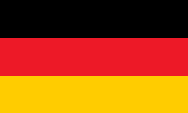

- Canadian province
- own names:
– Französisch: Nouveau Brunswick
– German: Neubraunschweig
• Flag
• Historical Flags
• Meaning/Origin of the Flag
• Coat of Arms
• Meaning/Origin of the Coat of Arms
• Map
• Numbers and Facts
• History
• Origin of the Country's Name
• regional Flags
– Acadia
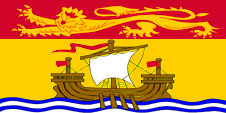
Flag of the Province of New Brunswick,
ratio = 1:2,
Source: Corel Draw 4






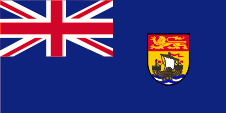
1868–1950,
Flag of the government (state flag),
ratio = 1:2,
Source, by:
World Statesmen



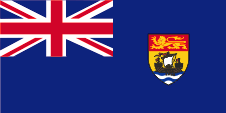
1950–1965,
Flag of the government (state flag),
ratio = 1:2,
Source, by:
Wikipedia (D),
World Statesmen




The flag of New Brunswick was adopet on 24th of February in 1965. It is a scutcheon flag, because it shows the design of the coat of arms of the province. Until the year 1922 there had officially been used, the British Union Jack, the so-called Royal Union Flag, by the departments of the provinces, or (from 1922 nearly only) the Canadian blue official flag, the typical British Blue Ensign, with the coat of arms of Canada in the flying end. Nevertheless, the provincial authorities had their own seals and later also coats of arms, which were unauthorized placed in the flying end of the blue official flag, in this way in New Brunswick from 1868. A permit should have been approved by the British authorities for this procedure, this was not the case, but was tolerated. The coat of arms in this flag had been modified in 1950 a little bit. The shape of the shield changed and the ship goes the other direction. Private individuals had to use the Union Jack and from 1892 the so-called Red Ensign, the red version of the Canadian flag with the Union Jack in the upper corner and the coat of arms of Canada in the flying end. In the course of the gradual separation of Canada from the United Kingdom the Blue Ensign as an official British flag lost its meaning and became replaced by new provincial flags, which may be used by authorities and departments of the provinces and also by private individuals. In this way, New Brunswick introduced the current flag in 1965. For this purpose, the image of the coat of arms was transferred to the entire surface of the flag. A procedure that was also used to change the provincial flags of British Columbia, Prince Edward Island and Nova Scotia. The flag of the province follows British specifications due to history. They are: Blue = Pantone 280, Red = Pantone 186, Yellow = Pantone 116. Before 1965, the Canadian state flag (Blue Ensign) officially had to be used by state offices. Unofficially, however, an own Blue Ensign – the British state flag with the coat of arms in the flying end – was used from 1868. Unofficially means here that this flag had never been approved by British authorities.
Source:
Volker Preuß,
Flaggen Enzyklopädie,
World Statesmen


Escutcheon of New Brunswick,
Source, by:
Corel Draw 4

There is a regular coat of arms for New Brunswick, with a console, shield holders (supporters), withe a crest and the motto. Here is only depicted the central part of the coat of arms, the escutcheon. The escutcheon of New Brunswick shows in the upper part a golden British lion on red ground, a hint for the connexions to
United Kingdom. Underneath a ship on ocean's waves of the Atlantic, obvious a indication for the European settlement.
Source:
Volker Preuß,
Wikipedia (EN)

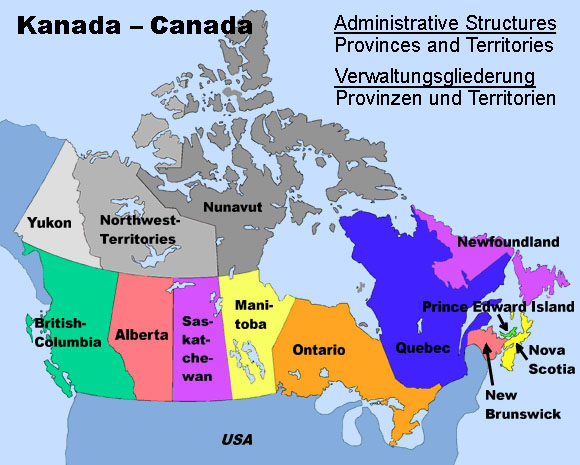
Map:
Volker Preuß

Area: 28.150 square miles
Inhabitants: 756.800 (2016), thereof 65% Anglo Canadians, 35% Franko Canadians (Acadians)
Density of Population: 27 inh./sq.mi.
Capital: Fredericton (Frederick's Town), 56.200 inh. (2011)
official Languages: English, French
Currency: Canadian currency
Time Zone: GMT – 4 h
Source:
Wikipedia (D)

1534 · the Frenchman Jacques Cartier discovers and explores the coast of the today's New Brunswick (Miramichi Bay)
1604 · expedition of colonization by Samuel de Champlain in the region of the today's City Saint John, he appropriates the land for France
1608 · summary of all French possessions in the today's Canada as "New France"
1663 · New France becomes a French crown colony
1713 · Peace of Utrecht, France has to cede the today's New Brunswick, Nova Scotia and the Island of Newfoundland to
United Kingdom
1776 · because of anti-British riotings escape English settlers from New England into the today's New Brunswick, defence of attacks from New England
1768 · foundation of the city Fredericton, named after the second son of King George III. of England
1783 · thousands of loyal English settlers escape from the USA into the today's New Brunswick
1784 · New Brunswick becomes an own province by separation from the Province of Nova Scotia, the name New Brunswick has its origin in the German Electorate of Brunswick-Lueneburg (Braunschweig-Lüneburg) over that at that time ruled the English King George III. (from the German House of Hanover)
1785 · Fredericton becomes capital of the province
1867 · establishment of the Confederation of Canada (Dominion of Canada – with an own parliament) because of demands for autonomy, confederation of the four founding provinces New Brunswick, Québec, Ontarioand Nova Scotia
Source:
Atlas zur Geschichte,
World Statesmen,
Wikipedia (D),
Discovery '97

The name of New Brunswick, which was founded in 1784, originates in the German Electorate of Brunswick-Lueneburg. Its elector, from the German Dynasty of Hanover, wast the time the English king as George III.
Source:
Volker Preuß


![]()












